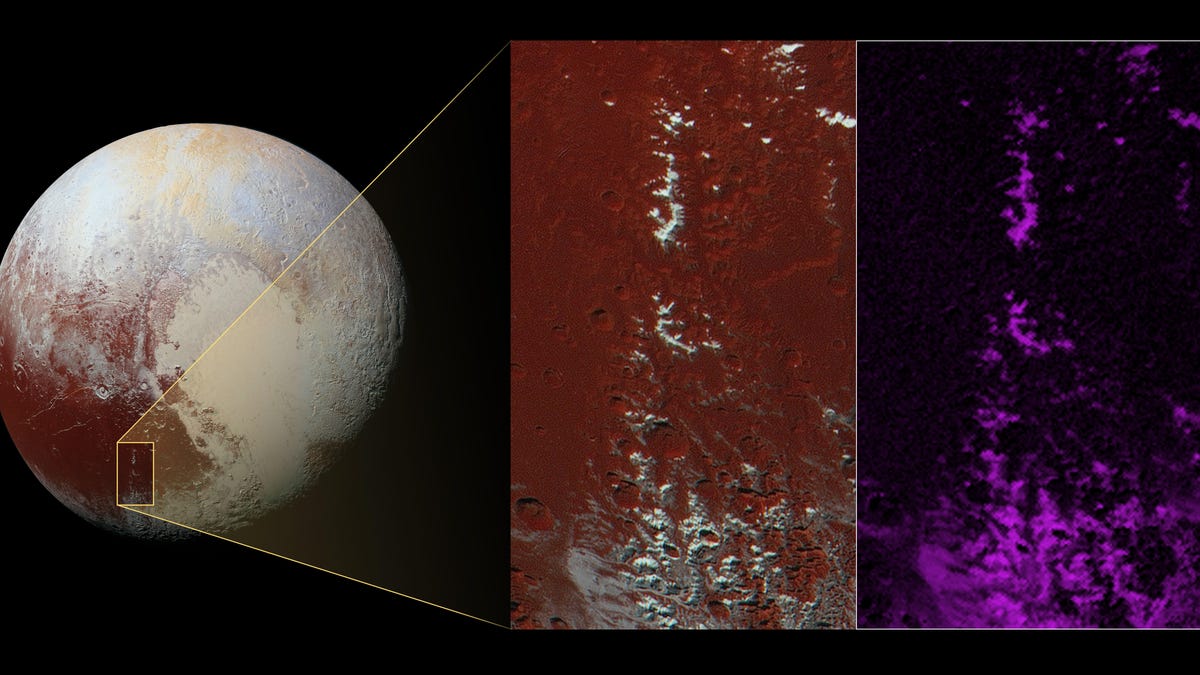Pluto's Cthulhu mountains look just like the Alps but they're not capped with snow
Even though they may look like the Alps, the dwarf planet's icy peaks are composed of methane-ice.

The methane-capped mountains of Pluto's Cthulhu region. False color images, in purple, show methane across the region correlates with the snow caps.
Gazing at Pluto's Cthulhu mountain range from space, you could mistake it for the Alps, Europe's picturesque spine of rock dusted with snow. When NASA's New Horizons spacecraft zipped past the dwarf planet in 2015, it imaged Cthulhu and the region's dazzling, reflective spine of mountains, which ascend to almost half the height of Mount Everest. It's cold on Pluto, way out at the edge of the solar system, and while peaks in Cthulhu may resemble the Alps, they're not capped with snow. They're frozen over with methane-rich ice.
Not the best place to go skiing, then.
A new study, published in the journal Nature on Tuesday, attempts to understand the mechanisms driving the formation of the Methane Alps, which has been something of a mystery. Some of the regions imaged by New Horizons showed features strikingly similar to those on Earth. Using high-resolution simulations, a team of planetary scientists have shown that looks can be deceiving -- the methane-ice mountains are likely formed in the opposite way to the Alps' snow-capped peaks.
On Earth, winds drive moist air up the side of mountains where cold temperatures cause water to condense and form snow which falls onto mountaintops. But that process is due to Earth's atmospheric conditions. Pluto's atmosphere is much thinner and even collapses as it moves from from the sun. And unlike Earth, temperature increases as you move upward in the atmosphere. The methane-ice can't be explained by processes we understand down here.
But by recapitulating Pluto's climate and methane cycle in numerical simulations, the team were able to create a model that agreed with the observations from NASA's New Horizons and other observations taken from Earth.
The new work suggests Pluto's methane-ice peaks are like a Bizarro-Alps where everything is backward.
The thin atmosphere of Pluto is warmer than its surface and carries methane gas from the northern hemisphere to equatorial plains like the Cthulhu region. The air above these regions is rich with methane gas, which condenses at night across the entire area.
"When it meets the mountains that poke up into these layers, it can condense to the frost [the researchers] see on the mountains," says Helen Maynard-Casely, a planetary scientist at Australia's Nuclear Science and Technology Organisation not affiliated with the study.
During the day, much of the frozen methane in the region sublimates, turning from solid to gas. However, at higher altitude, like Cthulhu's peaks, it persists during the day, which allows it to slowly build up over time.
The team conclude that it's remarkable to find two phenomena producing similar landscapes that are formed by such dissimilar processes. Understanding the methane cycle on Pluto, they suggest, might help explain other unique features of the dwarf planet's surface.
The Tartarus Dorsa mountains, photographed by New Horizons, are bizarrely textured, showing "intricate by puzzling patterns of blue-gray ridges and reddish material in between," according to NASA. This "bladed" texture may be a result of methane condensation.
Updated Oct. 13: Added HMC comment, clarified condensation process. Mountains aren't made of snow, so we changed the headline.

